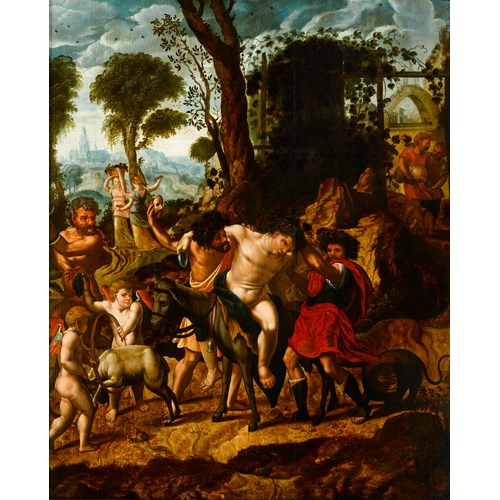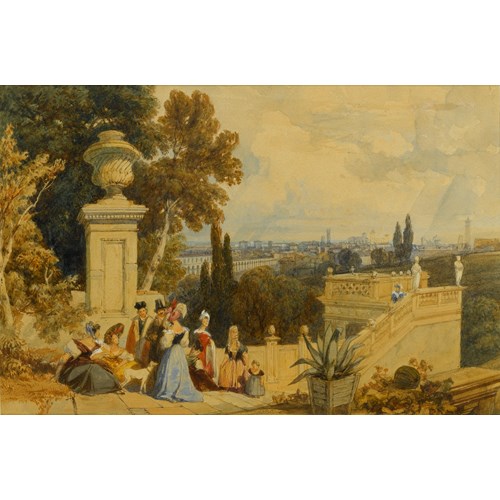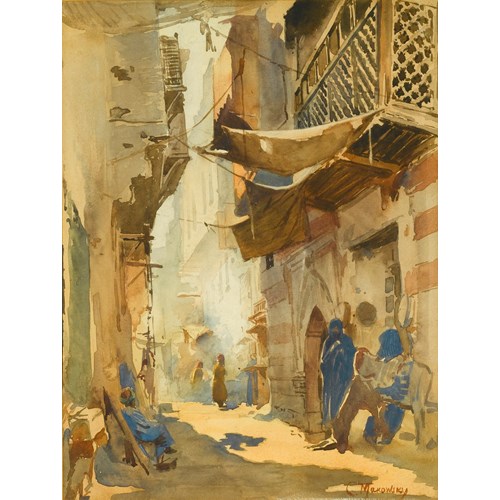Marketplace
The Sense of Taste
Jan Molenaer II
The Sense of Taste
Period 1600-1750, 17th century
Origin The Netherlands
Medium Oil on panel
Dimension 11.4 x 10.2 cm (4¹/₂ x 4 inches)
In this diminutive but charming panel, an inebriated drinker turns to meet the viewer’s gaze. In his left hand he holds up a full glass, whilst his squint, smirk and glowing nose indicate his drunken state. He is a comical and engaging figure, representing Taste, and the painting would presumably have once been part of a series of works representing the Five Senses.
Peasant scenes were a common subject for Jan Molenaer II, and often they represented one of the Five Senses. In another similarly small panel he painted A Sense of Smell (Private Collection). This work is slightly cruder than The Sense of Taste, both in terms of execution and the approach to the subject matter. When representing Taste, Molenaer has depicted a raffish, amiable figure, whose drunkenness is overt. However, the narrative is not as theatrical as it is in The Sense of Smell.
The Five Senses were a common subject for artists in the Northern Netherlands during the seventeenth century, and were part of a long tradition in Dutch art.¹ However, the subject matter was treated with great variety by artists. Adrian Brouwer’s (1605-1638) The Bitter Potion (Städelsches Kunstinstitut und Städtische Galerie, Frankfurt am Main), shows a man whose disgust, at what he has just tasted, appears to be verging on anger. Molenaer’s The Sense of Taste, like the famous treatment by his namesake Jan Miense Molenaer (1610-1668), lacks the aggressiveness of Brouwer’s work, preferring to focus on the comic aspect.²
Little is known about Molenaer’s life, other than that he is recorded as a Master of the Haarlem Guild of St. Luke in 1684. His identity and work have frequently been confused with both Jan Miense Molenaer, who is a clear influence, and a Jan Jacobsz. Molenaer.³ However, in recent years scholars have started to construct a coherent ouevre, which is focused around depictions of peasant life. He frequently painted en grisaille, and the subtle charm of The Sense of Taste is testament to his ability.
¹ For an extensive examination of the development of this theme, see Nordenfalk, C., ‘The Five Senses in Flemish Art before 1600’, in Netherlandish Mannerism, Cavalli-Björkman, G. (ed.), Stockholm (Nationalmuseum) 1984, pp. 135-54; Idem, ‘The Five Senses in Late Medieval and Renaissance Art,’ Journal of the Warburg and Courtauld Institutes, 48 (1985), pp. 1-22.
² For a discussion of the comic in Jan Miense Molenaer’s Five Senses, see Schiller, N., ‘“To See Ourselves Greatly Misled”: The Laughing Deceptions of Jan Miense Molenaer’s Five Senses (1637)’, in Canadian Journal of Netherlandic Studies, (XXVIII, 2007), pp. 76-104.
³ Jan Jacobsz Molenaer is recorded as a member of the Haarlem Guild of St. Luke in 1643. See Miedema, H., De archiefbescheiden van het St. Likasgilde te Haarlem, (Alphen aan den Rijn, 1980), vol. 2, pp. 595-596.
Peasant scenes were a common subject for Jan Molenaer II, and often they represented one of the Five Senses. In another similarly small panel he painted A Sense of Smell (Private Collection). This work is slightly cruder than The Sense of Taste, both in terms of execution and the approach to the subject matter. When representing Taste, Molenaer has depicted a raffish, amiable figure, whose drunkenness is overt. However, the narrative is not as theatrical as it is in The Sense of Smell.
The Five Senses were a common subject for artists in the Northern Netherlands during the seventeenth century, and were part of a long tradition in Dutch art.¹ However, the subject matter was treated with great variety by artists. Adrian Brouwer’s (1605-1638) The Bitter Potion (Städelsches Kunstinstitut und Städtische Galerie, Frankfurt am Main), shows a man whose disgust, at what he has just tasted, appears to be verging on anger. Molenaer’s The Sense of Taste, like the famous treatment by his namesake Jan Miense Molenaer (1610-1668), lacks the aggressiveness of Brouwer’s work, preferring to focus on the comic aspect.²
Little is known about Molenaer’s life, other than that he is recorded as a Master of the Haarlem Guild of St. Luke in 1684. His identity and work have frequently been confused with both Jan Miense Molenaer, who is a clear influence, and a Jan Jacobsz. Molenaer.³ However, in recent years scholars have started to construct a coherent ouevre, which is focused around depictions of peasant life. He frequently painted en grisaille, and the subtle charm of The Sense of Taste is testament to his ability.
¹ For an extensive examination of the development of this theme, see Nordenfalk, C., ‘The Five Senses in Flemish Art before 1600’, in Netherlandish Mannerism, Cavalli-Björkman, G. (ed.), Stockholm (Nationalmuseum) 1984, pp. 135-54; Idem, ‘The Five Senses in Late Medieval and Renaissance Art,’ Journal of the Warburg and Courtauld Institutes, 48 (1985), pp. 1-22.
² For a discussion of the comic in Jan Miense Molenaer’s Five Senses, see Schiller, N., ‘“To See Ourselves Greatly Misled”: The Laughing Deceptions of Jan Miense Molenaer’s Five Senses (1637)’, in Canadian Journal of Netherlandic Studies, (XXVIII, 2007), pp. 76-104.
³ Jan Jacobsz Molenaer is recorded as a member of the Haarlem Guild of St. Luke in 1643. See Miedema, H., De archiefbescheiden van het St. Likasgilde te Haarlem, (Alphen aan den Rijn, 1980), vol. 2, pp. 595-596.
Period: 1600-1750, 17th century
Origin: The Netherlands
Medium: Oil on panel
Signature: Signed with monogram 'JMR' (in ligature, upper right)
Dimension: 11.4 x 10.2 cm (4¹/₂ x 4 inches)
More artworks from the Gallery









